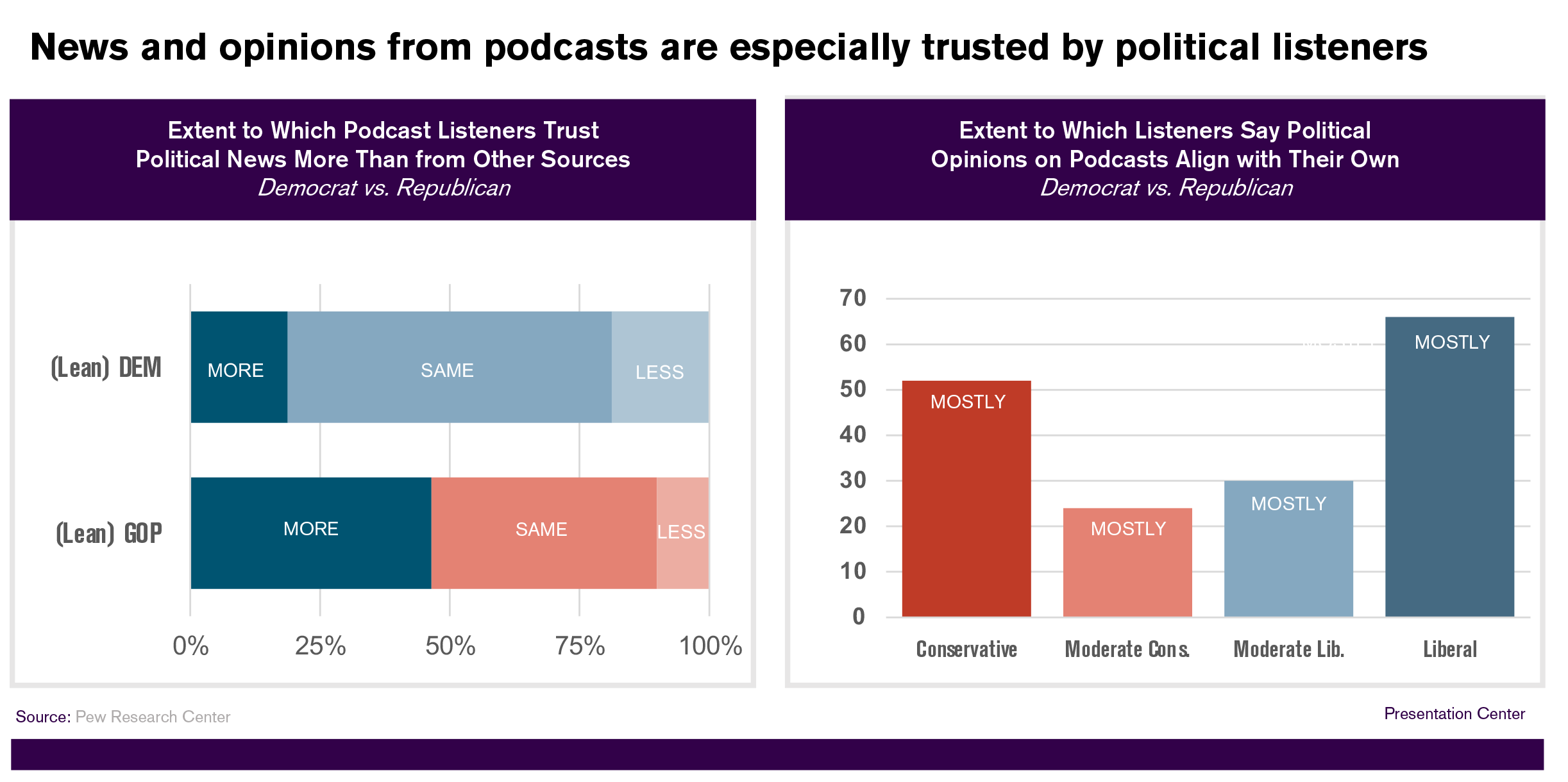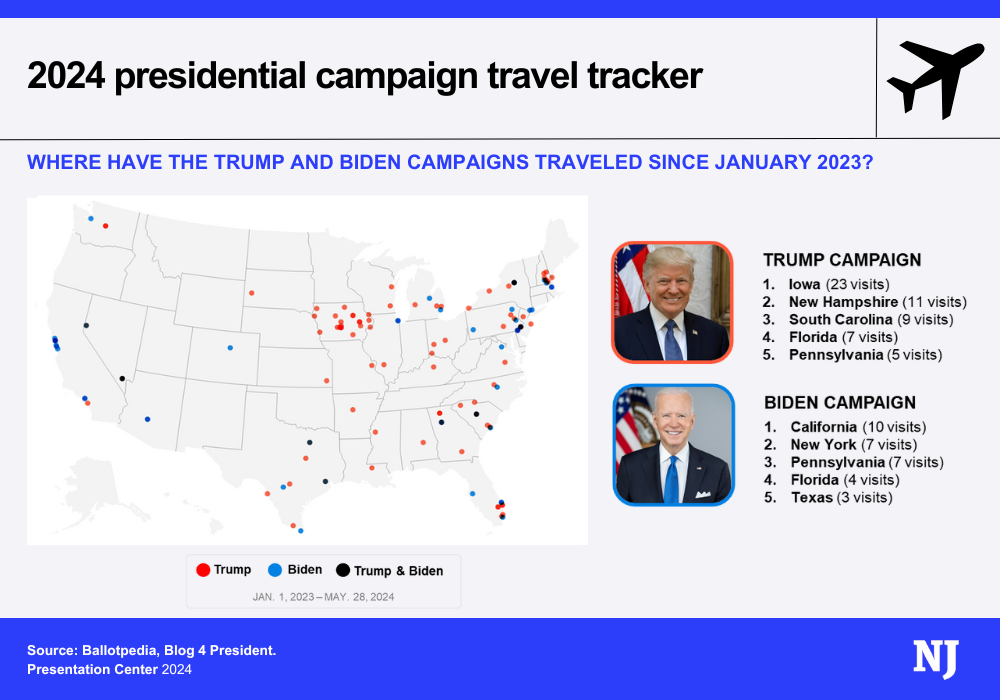Editor's Note: This story first appeared in Margins to Mainstream, our new special report on alternative media. Click here for the entire issue.
The path to success in the midterms for Democrats runs right through the bloc of America's youngest voters. But after the 2024 election highlighted an unexpected rightward shift amongst the crucial cohort, it’s imperative for the party and its candidates to develop effective anti-Trump messaging, as well as maneuver through the fracturing media landscape.
They first have to figure out how to record that selfie video, or which podcast they’ll need to appear on.
More often than not last year, Republican campaigners pivoted to the evolving media universe with more agility than their Democrat counterparts. Donald Trump and his allies regularly appeared on in-demand podcasts during the campaign, elevating him among the young, low-propensity voters who helped him secure a second term.
Young men in particular backed Trump and the GOP at numbers not seen in decades, a shift that experts say can be drawn back to media consumption—often exacerbated by algorithms.
Rachel Janfaza, a writer and researcher focused on youth culture, told National Journal that young people have begun to “notice that their social media algorithms feed them content that is really gender specific."
"And so if you look at a young man and a young woman's social media feed, whether that's on TikTok, Instagram, YouTube, they're going to be getting different content depending on what gender they are and the type of content that they've clicked on before,” Janfaza said.
“They've expressed feelings like it's really hard to break out of that once the algorithm knows that about them,” she said, noting that Trump and his campaign “leaned into this and went on a podcast tour traversing what everyone has called ‘the manosphere ecosystem.'”

Democratic strategist David Shor’s firm Blue Rose Research conducted 26 million voter interviews for a wide-ranging study of last year’s election. Shor told Vox last month that the study found the “single biggest predictor of swing from 2020 to 2024 is age.”
Voters under the age of 25 were more conservative than their millennial counterparts, but the gender gap has doubled. Trump narrowly won nonwhite, 18-year-old men—something Shor says hasn’t happened in Democratic politics before.
Brilyn Hollyhand, chair of the Republican National Committee’s Youth Advisory Council, agrees that young Americans decided the 2024 election for Trump, arguing that this cohort would continue to support the president and the GOP in future cycles.
“And I fully believe that the reason that we will have and continue to have a majority in ‘26 will be because of Gen Z getting out and making an effort to actually partake in that election,” he said.
Hollyhand, an 18-year-old high school senior from Tuscaloosa, Alabama, told National Journal that the RNC “basically had nonexistent campaign outreach” on social media prior to the 2024 election.
Under his tenure, he said he advocated for the presidential primary debates to be streamed online through platforms such as YouTube and Rumble, and told Trump to take advantage of TikTok, comparing it to former President Obama’s use of Twitter in his presidential campaigns.
“[Democrats are] owning the ‘For You’ page, and we're just sitting there on our hands because we have this self-imposed and ‘you're all high and mighty’ boycott,” Hollyhand said, recalling a conversation he had with Trump in August 2023. “I said, ‘I promise, Mr. President, you get on the platform, your numbers will be through the roof.' He loves big numbers, and he did, and he got on the platform.”

Trump ultimately joined TikTok last June despite having pushed for a ban on the platform during his first term. By the next day, he amassed more than 1 million followers after posting a video alongside UFC CEO Dana White during a championship fight in Newark, New Jersey.
The president's follower count currently sits at over 15 million, but he hasn’t posted on his account since Election Day.
Shor’s 2024 election study found voters who got their news through TikTok swung to the GOP by nearly 6 points from 2020 to 2024, more than voters whose news diet came from other platforms.
Now, in the aftermath of Trump’s win, Democrats are reevaluating not only their messaging, but also their current disadvantage in alternative media.
Kat Abughazaleh, a 26-year-old social media influencer challenging Rep. Jan Schakowsky from the left, says the Democratic Party’s hemorrhaging of young voters goes beyond their unfavorable placement in alternative media.
“I feel like many of them don't understand or [are] taking the wrong lessons from Joe Rogan and the right-wing media ecosystem, because the model that they're thinking of essentially depends on misinformation and lies,” Abughazaleh told National Journal. “I think that there's a way to do this that's not that, and that's by not only engaging with, but investing in creators and entertainers through a wide array of topics and expertise, ages, races.”
Abughazaleh, who previously worked at the liberal watchdog Media Matters For America, is familiar with the right-wing ecosystem’s messaging. She gained popularity on TikTok for critiquing conservatives and Fox News segments, amassing a following of more than 230,000. Abughazaleh said she’s drawing from her expertise to reach young voters across the political spectrum.
“I'm just trying to do all of the things that I think our politicians should be doing if they want to win elections,” she said. “You know, I make explainers and content about the Far Right. I have my own style, and I'm not very good at pretending to be someone else, and so I'm just kind of trying to talk to as many people as possible.”
Democrats’ messaging tactics have evolved rapidly in the months since Trump took office, with lawmakers eagerly looking beyond cable news and traditional media, as Trump did ahead of his 2024 victory.
“What Republicans did so well is that they politically coded culture instead of trying to culturally code politics,” Janfaza said.
“Democrats have been seen as the party that all of Hollywood aligns with and stereotypes like that, and I think that by bringing politics to these sort of cultural moments in the country, whether it was Trump going to a UFC fight, or even once he's been in office going to the Super Bowl or Daytona 500, [Republicans are bringing] a political figure to the culture that resonates with so many Americans,” she said.
And now Democrats have shifted gears: Senators launched a coordinated social media campaign ahead of Trump’s joint address to Congress called “Shit That Ain’t True.” Sen. Cory Booker broke the record for longest speech on the Senate floor, railing against the Trump administration. Highlight packages of the speech generated millions of views online.
Most recently, Sen. Bernie Sanders, as part of a multistate town-hall blitz across the country, surprised festival-goers when he delivered an impromptu speech at Coachella and made a direct appeal to thousands of young voters in the audience.
“This country faces some very difficult challenges. And the future of what happens to America is dependent upon your generation,” Sanders said. “We need you to stand up for justice, to fight for economic justice, social justice, and racial justice.”
Janfaza said, “I think that we are seeing Democrats embrace this new media a little bit more as well, almost because they have to, because Trump is doing it so aggressively.
“I think there's just a real hunger in what [young voters] feel is a vacuum of leadership for something visible,” she said. “That's the point. It has to be visible, whether it's a podcast or whether it's creating your own content by manufacturing these viral moments.”







